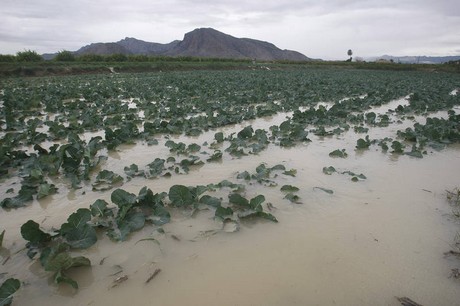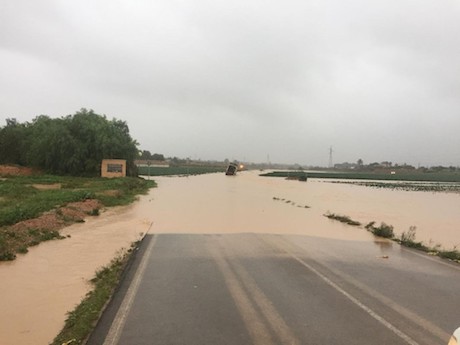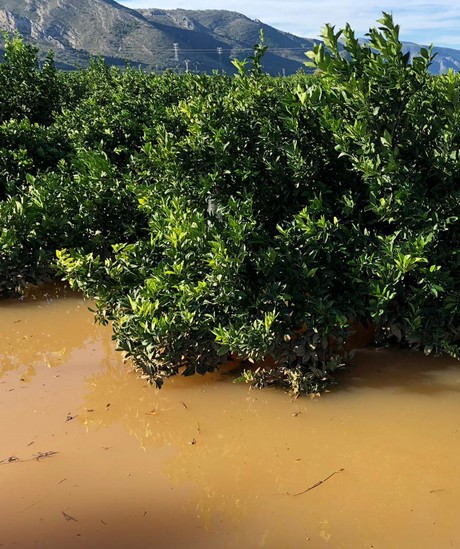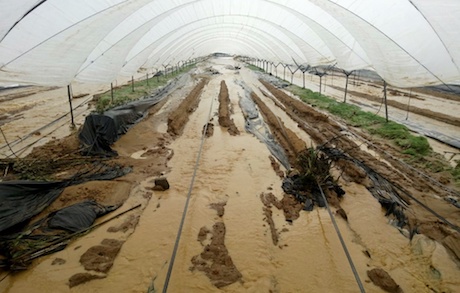Since last week, Spain has been going through a period of heavy rain events which are certainly taking a toll on the fruit and vegetable sector. Depending on the production area, the damage translates into production losses, impact on the crops' quality and delays in the shipments, both now and for future harvests.
In Murcia, leafy vegetables are the most affected
Since last Friday, most vegetable producers and exporters in the Region of Murcia have had no access to their fields due to the heavy rainfall and have been unable to continue with the harvest. In Murcia, this is already the second week in a row with rainy weather.

"In one weekend, we have had a third of the rainfall that we usually get in this area in an entire year. The fields are flooded or muddy and it is impossible to work on them," says Ginés Navarro, of the Murcian company Agridemur; a producer and exporter of leafy vegetables and salad bags. "This situation is causing delays in the shipment of the orders, making it impossible to adhere to the programs agreed with our customers. Moreover, the transport strikes in France are only making matters worse," he adds.
"We are evaluating the damage with our technicians and we don't yet have accurate figures, but leafy vegetables such as lettuce and spinach will see their quality affected by the mud and soil washed away by the water. There could also be crops suffering root asphyxia due to the excess water in the soil," says the producer.

Sources of Proexport report that crops such as broccoli or cauliflower will not be affected other than by delays in the harvesting and shipments. Therefore, leafy vegetables are the crops most affected by the mud, and their market price may be reduced.
Quality of citrus fruits in jeopardy and harvest delay
The persistent rainfall of the past six days in the fields of Valencia will cause significant damage both to the main crops whose season is currently in full swing and to agricultural infrastructure. According to an urgent first assessment carried out by the Valencian Association of Agricultural Producers (AVA-ASAJA), the losses will be worth at least 70 million Euro, although this figure could end up being much higher and reach up to 120 million, depending on the development of the weather conditions. Factors such as the humidity, high temperatures or occasional episodes of new rainfall will determine the extent of the impact on the region's agriculture.

The most affected agricultural productions are, in this order, citrus fruits, kakis and vegetables. The losses expected for citrus fruits alone (mainly for clementines, but also oranges) are estimated at between 50 and 100 million Euro, as between 250,000 and 500,000 tons are directly affected. The main causes of the damage are the flooding of the orchards (the stress of the roots forces the trees to let the fruits drop, and in the most severe cases, root asphyxia can kill the tree), the pixat (a physiopathy that causes the skin of clementines to deteriorate due to sudden changes in humidity, to such an extent that it makes the fruit unmarketable), and the aguado (a disease caused by the fungus Phytophthora which results in the fruit rotting). The comarcas of La Ribera, La Safor, La Costera and La Hoya de Buñol are the most affected by these issues.
The losses in the kaki sector will oscillate between 5 and 8 million Euro, with most of them recorded in the region of La Ribera. A total of 20,000 to 40,000 tons of kakis will suffer irreversible damage due to the flooding of the fields. This adds to the 35% drop in the Valencian production of kakis, which had already been caused by spring frosts and, above all, hail in July.
As for vegetables, the value of the damages caused by the water over the past week are estimated at between 1 and 3 million Euro, while the production volume harmed oscillates between 2,000 and 4,000 tons. The most affected crops are onions, cabbages, cauliflowers and artichokes in the regions of l'Horta and Camp de Túria, both because of the reduction in the harvest and because of the extra expenses that growers will have to make in fungicide treatments. The rain has also delayed the harvesting of the tiger nut and, in turn, the subsequent planting of other horticultural crops in those same fields.
Lastly, the association estimates the value of the damage caused to agricultural infrastructure, including greenhouses, walls or rural roads, at between 10 and 15 million Euro.
Damage to strawberries from Huelva
The rains recorded on Sunday in various municipalities of the coast of Huelva have caused damage in some 150 hectares of farms dedicated mainly to the cultivation of strawberries.

As reported by the Association of Producers and Exporters of Strawberries from Huelva, the rains have mainly affected farms in the municipalities of Lepe, Isla Cristina and Cartaya.
Some associated companies of Freshuelva, such as Agromartín and Freslucena, have reported severe damages on their Lepe farms, still pending assessment. In the case of Freslucena, some 10 hectares have been hit. These were the last ones to be planted that were not yet covered.
In the case of Isla Cristina, the City Council has reported that the most severe damage to agricultural crops have been recorded in La Redondela.
Source - http://www.freshplaza.com
 "In one weekend, we have had a third of the rainfall that we usually get in this area in an entire year. The fields are flooded or muddy and it is impossible to work on them," says Ginés Navarro, of the Murcian company Agridemur; a producer and exporter of leafy vegetables and salad bags. "This situation is causing delays in the shipment of the orders, making it impossible to adhere to the programs agreed with our customers. Moreover, the transport strikes in France are only making matters worse," he adds.
"We are evaluating the damage with our technicians and we don't yet have accurate figures, but leafy vegetables such as lettuce and spinach will see their quality affected by the mud and soil washed away by the water. There could also be crops suffering root asphyxia due to the excess water in the soil," says the producer.
"In one weekend, we have had a third of the rainfall that we usually get in this area in an entire year. The fields are flooded or muddy and it is impossible to work on them," says Ginés Navarro, of the Murcian company Agridemur; a producer and exporter of leafy vegetables and salad bags. "This situation is causing delays in the shipment of the orders, making it impossible to adhere to the programs agreed with our customers. Moreover, the transport strikes in France are only making matters worse," he adds.
"We are evaluating the damage with our technicians and we don't yet have accurate figures, but leafy vegetables such as lettuce and spinach will see their quality affected by the mud and soil washed away by the water. There could also be crops suffering root asphyxia due to the excess water in the soil," says the producer.
 Sources of Proexport report that crops such as broccoli or cauliflower will not be affected other than by delays in the harvesting and shipments. Therefore, leafy vegetables are the crops most affected by the mud, and their market price may be reduced.
Quality of citrus fruits in jeopardy and harvest delay
The persistent rainfall of the past six days in the fields of Valencia will cause significant damage both to the main crops whose season is currently in full swing and to agricultural infrastructure. According to an urgent first assessment carried out by the Valencian Association of Agricultural Producers (AVA-ASAJA), the losses will be worth at least 70 million Euro, although this figure could end up being much higher and reach up to 120 million, depending on the development of the weather conditions. Factors such as the humidity, high temperatures or occasional episodes of new rainfall will determine the extent of the impact on the region's agriculture.
Sources of Proexport report that crops such as broccoli or cauliflower will not be affected other than by delays in the harvesting and shipments. Therefore, leafy vegetables are the crops most affected by the mud, and their market price may be reduced.
Quality of citrus fruits in jeopardy and harvest delay
The persistent rainfall of the past six days in the fields of Valencia will cause significant damage both to the main crops whose season is currently in full swing and to agricultural infrastructure. According to an urgent first assessment carried out by the Valencian Association of Agricultural Producers (AVA-ASAJA), the losses will be worth at least 70 million Euro, although this figure could end up being much higher and reach up to 120 million, depending on the development of the weather conditions. Factors such as the humidity, high temperatures or occasional episodes of new rainfall will determine the extent of the impact on the region's agriculture.
 The most affected agricultural productions are, in this order, citrus fruits, kakis and vegetables. The losses expected for citrus fruits alone (mainly for clementines, but also oranges) are estimated at between 50 and 100 million Euro, as between 250,000 and 500,000 tons are directly affected. The main causes of the damage are the flooding of the orchards (the stress of the roots forces the trees to let the fruits drop, and in the most severe cases, root asphyxia can kill the tree), the pixat (a physiopathy that causes the skin of clementines to deteriorate due to sudden changes in humidity, to such an extent that it makes the fruit unmarketable), and the aguado (a disease caused by the fungus Phytophthora which results in the fruit rotting). The comarcas of La Ribera, La Safor, La Costera and La Hoya de Buñol are the most affected by these issues.
The losses in the kaki sector will oscillate between 5 and 8 million Euro, with most of them recorded in the region of La Ribera. A total of 20,000 to 40,000 tons of kakis will suffer irreversible damage due to the flooding of the fields. This adds to the 35% drop in the Valencian production of kakis, which had already been caused by spring frosts and, above all, hail in July.
As for vegetables, the value of the damages caused by the water over the past week are estimated at between 1 and 3 million Euro, while the production volume harmed oscillates between 2,000 and 4,000 tons. The most affected crops are onions, cabbages, cauliflowers and artichokes in the regions of l'Horta and Camp de Túria, both because of the reduction in the harvest and because of the extra expenses that growers will have to make in fungicide treatments. The rain has also delayed the harvesting of the tiger nut and, in turn, the subsequent planting of other horticultural crops in those same fields.
Lastly, the association estimates the value of the damage caused to agricultural infrastructure, including greenhouses, walls or rural roads, at between 10 and 15 million Euro.
Damage to strawberries from Huelva
The rains recorded on Sunday in various municipalities of the coast of Huelva have caused damage in some 150 hectares of farms dedicated mainly to the cultivation of strawberries.
The most affected agricultural productions are, in this order, citrus fruits, kakis and vegetables. The losses expected for citrus fruits alone (mainly for clementines, but also oranges) are estimated at between 50 and 100 million Euro, as between 250,000 and 500,000 tons are directly affected. The main causes of the damage are the flooding of the orchards (the stress of the roots forces the trees to let the fruits drop, and in the most severe cases, root asphyxia can kill the tree), the pixat (a physiopathy that causes the skin of clementines to deteriorate due to sudden changes in humidity, to such an extent that it makes the fruit unmarketable), and the aguado (a disease caused by the fungus Phytophthora which results in the fruit rotting). The comarcas of La Ribera, La Safor, La Costera and La Hoya de Buñol are the most affected by these issues.
The losses in the kaki sector will oscillate between 5 and 8 million Euro, with most of them recorded in the region of La Ribera. A total of 20,000 to 40,000 tons of kakis will suffer irreversible damage due to the flooding of the fields. This adds to the 35% drop in the Valencian production of kakis, which had already been caused by spring frosts and, above all, hail in July.
As for vegetables, the value of the damages caused by the water over the past week are estimated at between 1 and 3 million Euro, while the production volume harmed oscillates between 2,000 and 4,000 tons. The most affected crops are onions, cabbages, cauliflowers and artichokes in the regions of l'Horta and Camp de Túria, both because of the reduction in the harvest and because of the extra expenses that growers will have to make in fungicide treatments. The rain has also delayed the harvesting of the tiger nut and, in turn, the subsequent planting of other horticultural crops in those same fields.
Lastly, the association estimates the value of the damage caused to agricultural infrastructure, including greenhouses, walls or rural roads, at between 10 and 15 million Euro.
Damage to strawberries from Huelva
The rains recorded on Sunday in various municipalities of the coast of Huelva have caused damage in some 150 hectares of farms dedicated mainly to the cultivation of strawberries.
 As reported by the Association of Producers and Exporters of Strawberries from Huelva, the rains have mainly affected farms in the municipalities of Lepe, Isla Cristina and Cartaya.
Some associated companies of Freshuelva, such as Agromartín and Freslucena, have reported severe damages on their Lepe farms, still pending assessment. In the case of Freslucena, some 10 hectares have been hit. These were the last ones to be planted that were not yet covered.
In the case of Isla Cristina, the City Council has reported that the most severe damage to agricultural crops have been recorded in La Redondela.
Source - http://www.freshplaza.com
As reported by the Association of Producers and Exporters of Strawberries from Huelva, the rains have mainly affected farms in the municipalities of Lepe, Isla Cristina and Cartaya.
Some associated companies of Freshuelva, such as Agromartín and Freslucena, have reported severe damages on their Lepe farms, still pending assessment. In the case of Freslucena, some 10 hectares have been hit. These were the last ones to be planted that were not yet covered.
In the case of Isla Cristina, the City Council has reported that the most severe damage to agricultural crops have been recorded in La Redondela.
Source - http://www.freshplaza.com











